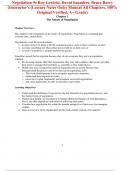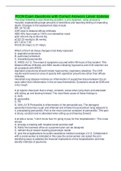Negotiation 9e Roy Lewicki, David Saunders, Bruce Barry
(Instructor's (Lecture Notes Only) Manual All Chapters, 100%
Original Verified, A+ Grade)
Chapter 1
The Nature of Negotiation
Chapter Overview
This chapter is the foundation for the nature of negotiations. Negotiation is something that
everyone does, almost daily.
Negotiations occur for several reasons:
1. to agree on how to share or divide a limited resource, such as land, or money, or time
2. to create something new that neither party could do on their own; or
3. to resolve a problem or dispute between the parties.
Sometimes people fail to negotiate because they do not recognize they are in a negotiation
situation.
• By choosing options other than negotiation, they may fail to achieve their goals, get what
they need, or manage their problems as smoothly as they might like to.
• People may also recognize the need for negotiation but do poorly because they
misunderstand the process and do not have good negotiating skills.
o This book should prepare you to recognize negotiation situations;
o understand how negotiation works;
o know how to plan, implement, and complete successful negotiations;
o and, most importantly, be able to maximize your results.
Learning Objectives
1. Understand the definition of negotiation, the key elements of a negotiation process, and
the distinct types of negotiation.
2. Explore how people use negotiation to manage different situations of interdependence—
that is, that they depend on each other for achieving their goals.
3. Consider how negotiation fits within the broader perspective of processes for managing
conflict.
4. Gain an overview of the organization of this book and the content of its chapters.
1
© McGraw Hill LLC. All rights reserved. No reproduction or distribution without the prior written consent of
McGraw Hill LLC.
,Chapter Outline
I. A Few Words about Our Style and Approach
II. Joe and Sue Carter
III. Characteristics of a Negotiation Situation
IV. Interdependence
A. Types of Interdependence Affect Outcomes
B. Alternatives Shape Interdependence
V. Mutual Adjustment
A. Mutual Adjustment and Concession Making
B. Two Dilemmas in Mutual Adjustment
VI. Value Claiming and Value Creation
VII. Conflict
A. Definitions
B. Levels of Conflict
C. Functions and Dysfunctions of Conflict
D. Factors That Make Conflict Easy or Difficult to Manage
VIII. Effective Conflict Management
IX. Overview of the Chapters in This Book
X. Chapter Summary
2
© McGraw Hill LLC. All rights reserved. No reproduction or distribution without the prior written consent of
McGraw Hill LLC.
, I. A Few Words about Our Style and Approach
• First a brief definition of negotiation—a form of decision making in which two or more
parties talk with one another in an effort to resolve their opposing interests.
o Moreover, the authors will be careful about the use of terminology in this book.
▪ Bargaining: describes the competitive win–lose situations (haggling).
▪ Negotiation: refers to win–win situations (to find mutually acceptable solutions).
• Second, many people assume the “heart of negotiation” is the give-and-take process used
to reach an agreement.
o While give-and-take is extremely important, negotiation is a very complex social
process, where many of the most important factors that shape the negotiation occur
before the negotiation, or shape the context around the negotiation.
• Third, the author’s insights into negotiation are drawn from three sources.
o Personal experience as negotiators on a daily basis
o Media—television, radio, newspapers, magazines, and the internet
o Nearly 60 years of research conducted on numerous aspects of negotiation
II. Joe and Sue Carter
In a single day, Joe and Sue Carter face the challenges of many major and minor
negotiations.
• The story is used to highlight three important themes.
o The definition of negotiation and the basic characteristics of negotiation situations.
o An understanding of interdependence, the relationship between people and groups
that most often leads them to need to negotiate.
o The definition and exploration of the dynamics of conflict and conflict management,
which is a backdrop for ways people approach and manage negotiations.
III. Characteristics of a Negotiation Situation
• Negotiation is a process by which two or more parties attempt to resolve their opposing
interests.
o Negotiation is one of the several mechanisms by which people resolve conflicts.
• Characteristics common to all negotiation situations include the following:
o There are two or more parties, individuals, groups, or organizations.
o There is a conflict of needs and desires between two or more parties, and the parties
must search for a way to resolve the conflict.
o Parties negotiate because they think they can get a better deal by negotiating than by
simply accepting what the other side will voluntarily give them or let them have.
o When negotiating, a give-and-take is expected.
▪ One side may violate the expectations of give-and-take
▪ See Box 1.1
3
© McGraw Hill LLC. All rights reserved. No reproduction or distribution without the prior written consent of
McGraw Hill LLC.
, o The parties prefer to negotiate and search for agreement rather than to fight openly,
have one side dominate and the other capitulate, permanently break off contact, or
take their dispute to a higher authority to resolve it.
o Successful negotiation involves the management of tangibles and also the resolution
of intangibles.
▪ Tangible factors: the price or the terms of agreement
▪ Intangible factors: the underlying psychological motivations that may directly or
indirectly influence the parties during a negotiation.
• Examples of intangible factors include:
o The need to “win” or avoid losing
o The need to look “good,” “competent,” or “tough” to those you’re
representing
o The need to defend an important principle or precedent in a negotiation
o The need to appear “fair” or “honorable” or to protect one’s reputation
o The need to maintain a good relationship
• Intangibles are often rooted in personal values and emotions and they
influence the negotiation processes and outcomes.
• It is impossible to ignore intangibles because they affect our judgment about
what is fair, right, or appropriate in the resolution of the tangibles.
▪ See Box 1.2 about the problems the urge to win creates for negotiators.
IV. Interdependence
• When the parties depend on each other to help achieve their own preferred outcome, they
are interdependent.
o Working interdependently allows parties to achieve a possible outcome that is better
than they could achieve by working on their own.
• Most relationships between parties may be characterized in one of three ways:
independent, dependent, or interdependent.
o Independent parties are able to meet their own needs without the help and assistance
of others.
o Dependent parties must rely on others for what they need; the dependent party must
accept and accommodate to that provider’s whims and idiosyncrasies.
o Interdependent parties are characterized by interlocking goals.
▪ The parties need each other in order to accomplish their objectives.
▪ Because of this, they have the potential to influence each other.
▪ A mix of convergent and conflicting goals characterize many interdependent
relationships.
• See Box 1.3 for a perspective on interdependence and the importance of intangibles.
A. Types of Interdependence Affect Outcomes
• The interdependence of people’s goals, and the structure of the situation in which
they are going to negotiate, strongly shapes negotiation processes and outcomes.
4
© McGraw Hill LLC. All rights reserved. No reproduction or distribution without the prior written consent of
McGraw Hill LLC.





